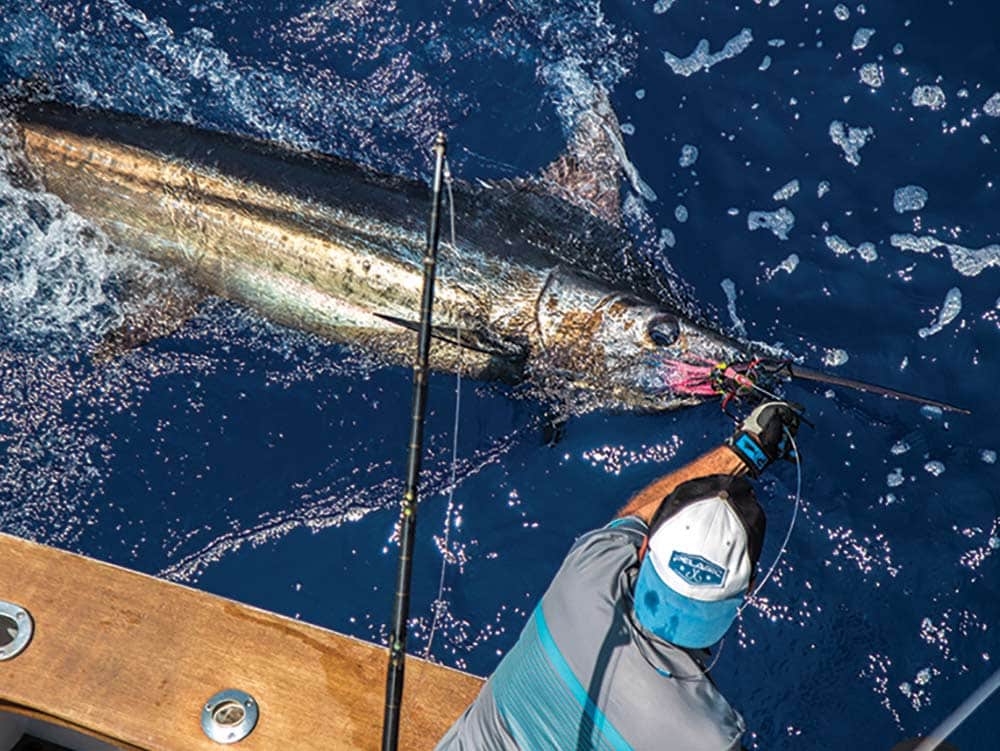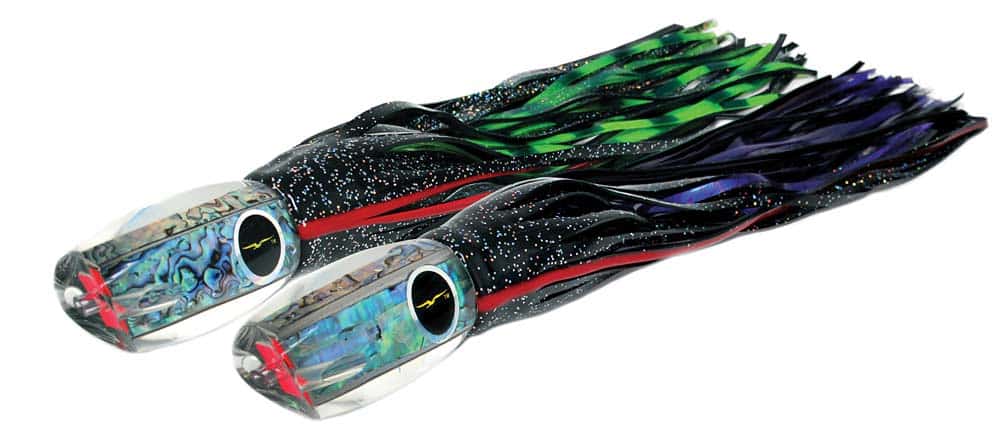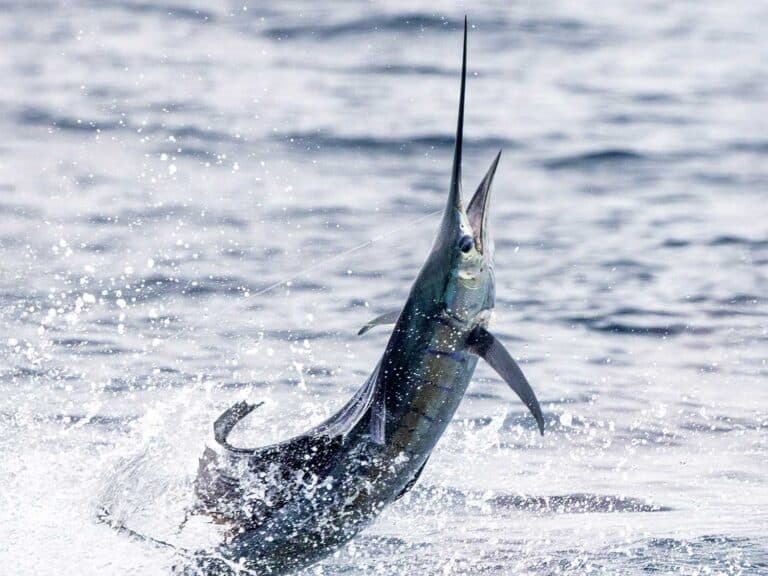
In the mid-1990s, I was a new arrival to the wonders of billfishing in the remote South Pacific. I outfitted a 41-foot aluminum-hulled sloop named Elan with outriggers and tackle, put my Florida Keys-based charter business on hold and sailed through the Panama Canal to see what I could discover in the wide Pacific Ocean. One cluster of idyllic, verdant islands in the middle of the South Pacific called the Vava‘u group particularly captured my imagination. It belongs to the last Pacific monarchy, the Kingdom of Tonga, and I felt going there might be similar in many ways to visiting Hawaii 100 years or so ago. During my second visit there in 1998, I met a Kiwi captain named Steve Campbell, who’d stopped en route from a season in Samoa with his 46-foot custom Alan Wright sport-fishing catamaran to fish the Tonga International Billfish Tournament. I guess Vava‘u had a similar effect on Campbell because by the year 2000 he was chartering there with better-adapted boats, and catching the heck out of blue marlin in the islands. He remains there to this day.

The Tonga Trench lies immediately east of these islands; seamounts and other sheer underwater topography abound, and the South Equatorial Current undulates and swirls through it all. Blue marlin are sufficiently abundant to target them year-round. Campbell, of course, does what most of us would do: He relentlessly fishes for them as often as possible. The difference between Campbell and most of us, however, is that he meticulously records every bit of data in spreadsheets each evening, without fail. He knows exactly the lure model, color, hook rig, position in the spread, location and so on for every blue marlin he’s released, and at the end of 2017, he’d caught 2,132 blues and counting — that’s between 83 and 158 each season (including storm-shortened years), averaging something like 1.7 releases per marlin trip. Needless to say, this may well be the most detailed body of data in existence about fishing for blue marlin, as well as a sufficiently large sample size for the numbers to speak for themselves.

Tonga fishing
A Look Behind the Data
Campbell effectively ran the data-collection side of his charter business, at least in some respects, like a science project. He is the first to point out, however, that the sample is obviously biased by his choice of lures, spread positions and so on, which is driven by what works for him. Success begets success: Lures that are raising fish get more time in the water, and of course, they put up bigger numbers due to running time than perfectly good lures sitting on the bench waiting to get in the game. Nonetheless, testing a wide array of lures and positions over thousands of trolling hours certainly has a great deal to say about what works in this location, but it is highly likely to be applicable to other blue marlin fisheries in the world. It just as certainly casts no shadows on other spreads, lures and strategies that are successful on other boats and locations, which, given adequate running time, could be just as successful when fished from Campbell’s boat, Blue Marlin Magic, in Tonga.

Tonga fishing
Rigs and Hook-Sets
Another thing Campbell experimented with in great detail was different hook rigs, assisted by running an underwater video camera for hundreds of trips over a period of years to study blue marlin strike behavior. Data from his first 12 seasons (2000 to 2011) showed that stiff rigs, with either a fixed or swinging hook, accounted for the vast majority of lure-caught blues (1,029 out of 1,267). Also, single-hook rigs caught 94 percent of all lure-caught blue marlin. Steve forms his stiff rigs using a stainless-steel rod inserted between two crimped sleeves. For a fixed hook, he pulls or cinches the mono loop through the hook eye tight to the crimp, which is further assisted by wraps of colored electrical tape. To rig the swinging hook, Campbell uses a Flemish double loop at the hook eye, which allows it to move freely at the end of the stiff rig. He switches to swinging hooks any time the blues begin to exhibit billing behavior, as opposed to just rushing in and engulfing the lure. This may occur for days at a time when surface bait schools are scarce or the marlin are diving deep to feed on slower-moving squid and mesopelagic fishes. During periods of this behavior, he also resorts to soft rigs and double hook-sets to improve his hookup rates. Otherwise, it’s nearly always a stiff rig with a single fixed hook.
“The vast majority of blues exhibited typical “strike and flight” behavior. They nearly always set up and lunged from the inside to the outside of the lure spread.”
Here’s another trick, and to me, this is pure genius. Remember that blue marlin largely use one eye at a time to track an erratic, fast-moving prey item or a lure, very likely with assistance from their lateral line receptors. They typically set up below and off to the side of the lure, then sweep up and across to engulf the lure, rather than grabbing and swallowing from behind. Reviewing hundreds of hours of video and observing thousands of bites, Campbell concluded something else: The vast majority of blues exhibited typical “strike and flight” behavior. They nearly always set up and lunged from the inside to the outside of the lure spread. So he began securing stiff fixed-hook rigs in the lures from the standard 90-degree straight-up position to 10 degrees offset from vertical, always inboard, pointing the hook slightly toward the middle of the spread (so the direction of the offset is opposite for port- and starboard-placed lures). A rubber grommet snugly placed in a shallow hole drilled in the back of each lure head, where the forward crimp of the stiff rig rides securely, locks the rig at the desired angle. This practice sharply increased Campbell’s successful hookup rates to approximately 80 percent of all lure strikes.

Spread Specifics
The basic framework for Campbell’s success is the staggered W-shaped spread, with short and long port and starboard lures, a shotgun lure long down the middle and a hookless teaser always run on the port side of the transom.
The first 12 years of statistics showed that of 1,267 lure-caught blues, the shotgun caught 31 percent, followed by the port long (25 percent); the starboard long (21 percent); port long flat (13 percent); and starboard short corner (10 percent). These numbers may reflect several factors: “pre-heating” of the port side of the spread by the teaser; that the distant lures are more often medium size or smaller, running in cleaner water and catch a larger range of marlin sizes; and the corollary that the big lures run close to the boat tend to attract less numerous, larger and older fish.
“Some lures popped and sizzled beautifully in a specific position but were dogs when it came to pulling fish into the spread.”
Embedded in all of this, of course, is exhaustive trial and error, testing hundreds of lures in all different spread positions. Some lures popped and sizzled beautifully in a specific position but were dogs when it came to pulling fish into the spread. Others raised fish but didn’t draw the bites, although there is still some value in this, as videos confirmed that marlin raised on one lure would frequently switch over and crash a different lure in the spread. Some lures had a higher hookup ratio in one position than in another. It’s critical also to match the specific size and style of hook rig to the lure, sea condition and position in the spread.

The Hot Colors
So, what colors produced the most bites? Detailed spreadsheets from Campbell’s first 12 seasons show that 748 of 1,267 lure-caught blue marlin ate lures skirted with black over purple or other purple combinations, and another 367 ate color combinations that included black, including black-and-orange, black-and-green and black-and-rainbow. This supports the sensible belief in matching the hatch because the blacks and purples certainly mimic one of the predominant bait species prevalent in Tonga: skipjack tuna. We know blue marlin possess the requisite pigments and cones on the ventral portion of the retina to distinguish purples, blues and greens but, as far as scientists have been able to ascertain, not other portions of the color spectrum. These numbers indicate the Vava‘u blues are definitely eating a lot of lures with those colors they are able to distinguish, and certainly they are eating colors that are more likely to create a sharp silhouette when viewed looking up toward the sea surface. Generalizing all of this, Campbell says, “Here in Vava‘u, a medium-size dark-blue or purple angle-faced lure is hard to beat.” His favorite overall hook rig would be a stiff fixed hook, often a Mustad 7732.

Tonga
Perhaps the most important aspect of being a successful billfish captain is consistency, which in the case of lure-fishing requires constantly identifying and deploying products that maximize captures over a spectrum of conditions. Campbell’s detailed data depicts 10 top individual lures from five manufacturers, but breaking out the same summaries from the next six seasons shows significant shifts because recently introduced products quickly gained ground and made the starting lineup. Data for the individual years of 2016 and 2017 show Nathan Adams’ Red Gill Lures surging to the top, for example.

Top Lures for a Decade-Plus
The top 10 lures in terms of absolute numbers of blue marlin caught over the first 12 seasons express seductiveness meeting opportunity, with the chance for a given lure to produce ultimately controlled by Campbell. I cannot overemphasize the dynamic nature, constant changes and evolution occurring in Campbell’s spreads as more seasons passed. Meridian, an Australian brand, came on strong, and not just the Ahi, but also the Demon, Quasi, XOS Quasi and XOS Spectre. He didn’t start using the Bonze Oceano lures from New Zealand until 2011, and the Bonze Here for the Party quickly garnered 24 blues in the month of July alone, as well as sailfish and other bluewater target species (Campbell caught 47 blues on the first 15 charters of that month, and 67 total in the 23 trips for the month). The Bonze Ballistic, Angel and Grimmel also got their share of attention. Other specific lures that did extremely well during specific times and seasons during this era include the Black Bart Brazilliano, Hollow Point Nitro, Black Magic Pursuit Prowler, Eye Catcher Magnum Kona, Pacific Angle Face, Legend Angle Face, Black Bart Oz Prowler, Black Bart Rum Candy and Tantrum Tube.
The Recent Data
Only three lures from the 2000-2011 period made the top 10 lures for the period from 2012 to 2017: Mold Craft Bobby Brown, Black Bart Hawaiian Breakfast and Meridian Ahi, largely due to Campbell deploying new lures from Bonze and Red Gill. The 2012-2017 top 10 lures caught 296 blue marlin, or 62.4 percent of the total catch for the six-year period. New lures of note include the Red Gill No. 8 and Fathom Pepal Grande, having only been deployed for several seasons. Over the six-year period, new lure entrants from Red Gill, Fathom and Matheson Specials caught 17.5 percent of the blue marlin total despite only being deployed for two seasons. Adding Bonze lures to this category ups that to 46 percent of blues caught in the past six seasons on these newcomers to the spread.
Nonetheless, the Mold Craft Bobby Brown remains the top catcher over 18 seasons with 138 blue marlin, followed closely by Meridian Ahi at 120 blues over 10 seasons. Black Bart’s Hawaiian Breakfast comes in third overall, catching 105 blues over 13 seasons. Campbell says, “The refinement of lure choice is never-ending. However, captains tend to establish a special box of catchers that span many years, with the likes of Mold Craft’s Bobby Brown and Wide Range, the Black Bart 1656 and Kona Classic, and similar iconic performers.”
Campbell says, “I still turn to my faithful Bobby Brown lures and get some nice fish, especially when conditions are tough, and I run stiff single fixed-hook rigs on most lures the vast majority of the time.” Campbell’s comprehensive book, Blue Marlin Magic (by Steve Campbell, Wild River Press, 2014, 579 pages), thoroughly discusses and documents these breakthroughs. I am not aware of anyone else with this kind of detailed blue marlin data gained from over a decade of hard fishing, combining near-scientific data collection with on-the-water observations to yield better results.
A Sample of Top Lures
Meridian Ahi
This is an example of a lure Capt. Steve Campbell first started testing in his ninth season. It quickly rose to prominence and became one of his most consistent blue marlin producers. This medium-size angle-faced lure head, enlarged at the front and tapering aft, pops and smokes well on the third to fifth wave and in all sea conditions. It balances well with a stiff single fixed or swinging hook and ranks at the very top for producing clean mouth hookups. This makes it a good choice when the blues start billing more than aggressively biting.
Red Gill RG4 M
This lure caught more blue marlin than any other lure fished from_ Blue Marlin Magic_ in 2017. It is an absolute top producer.

Mold Craft Bobby Brown

Bonze Lures








